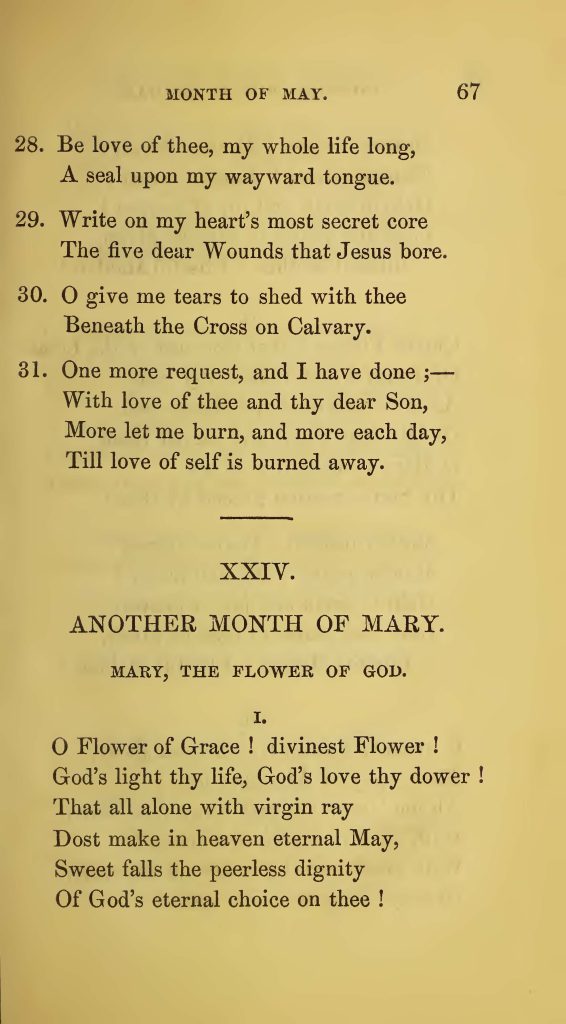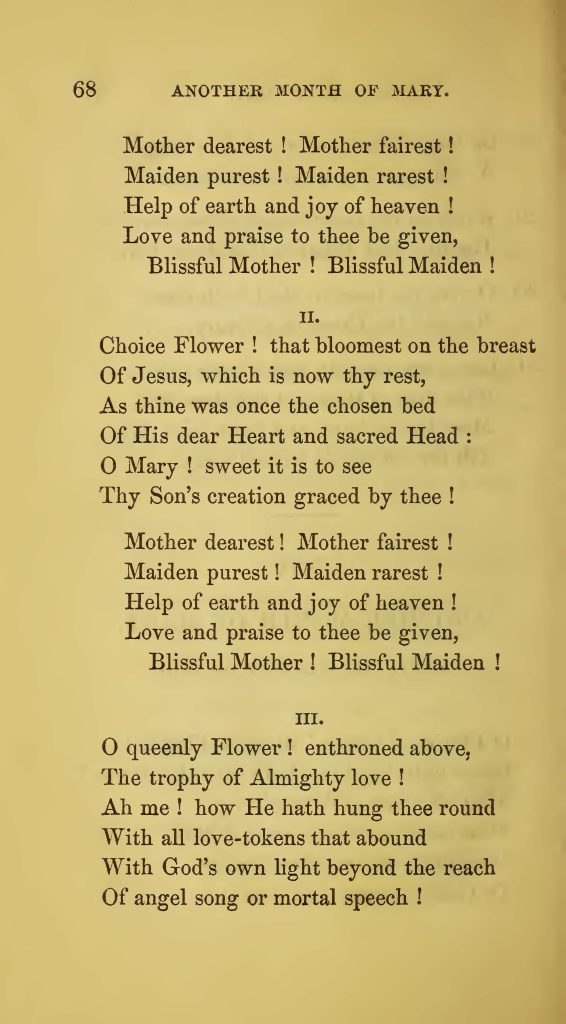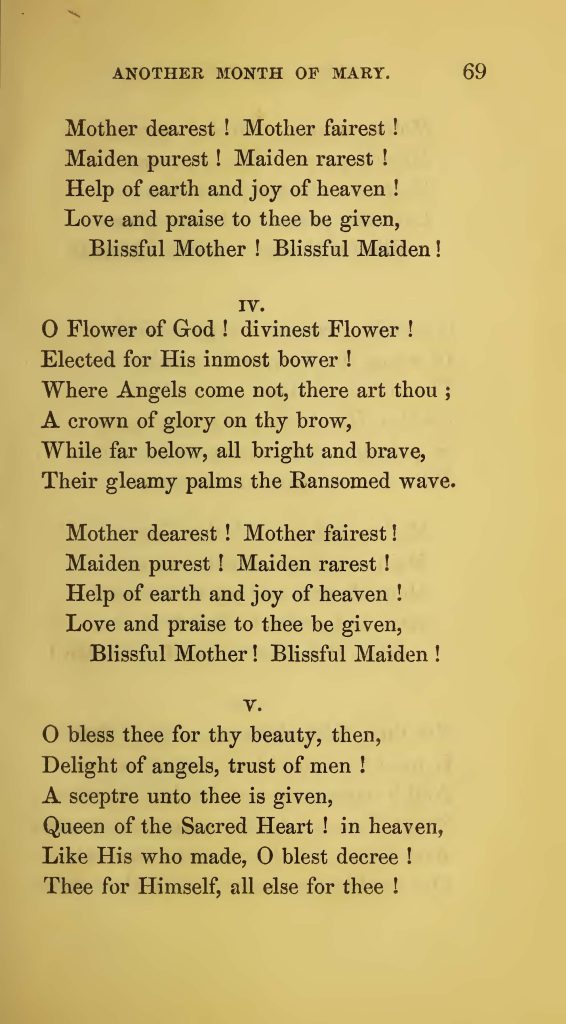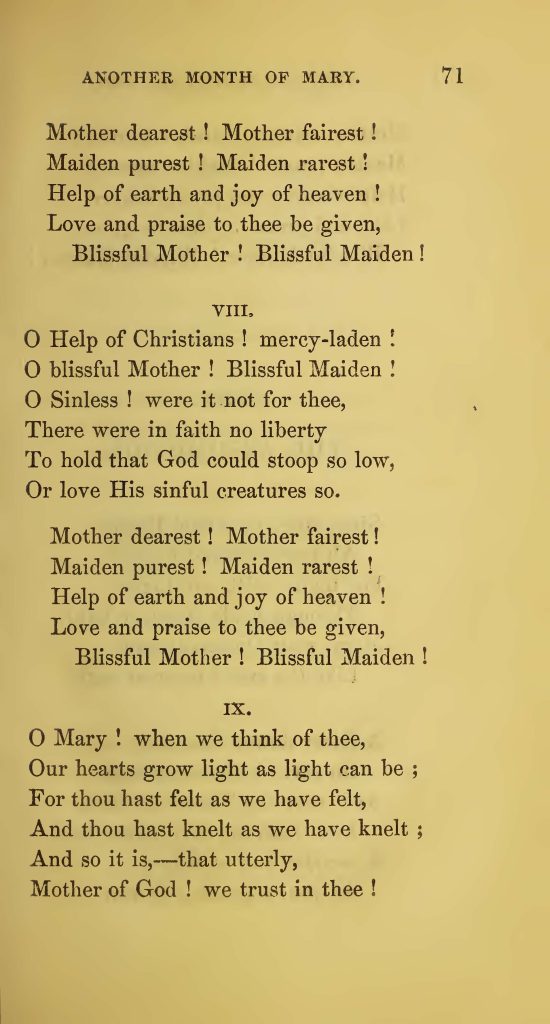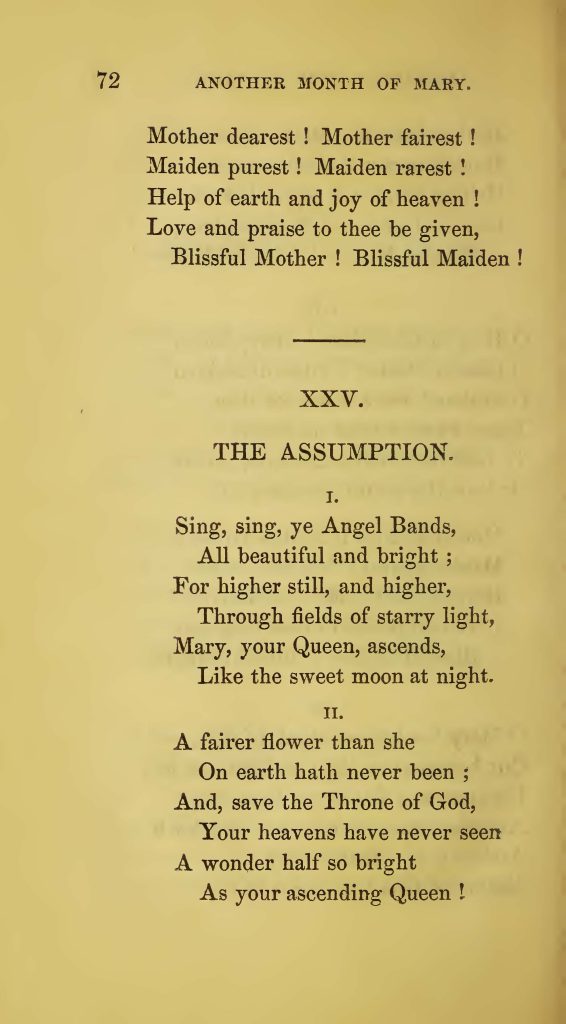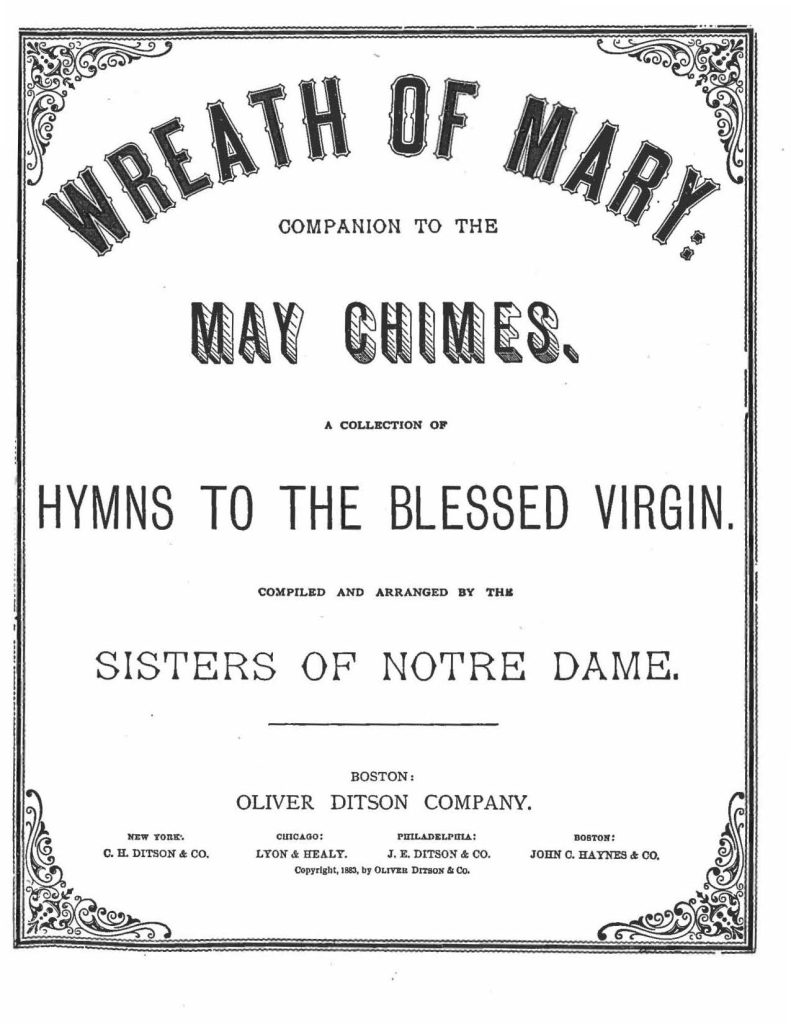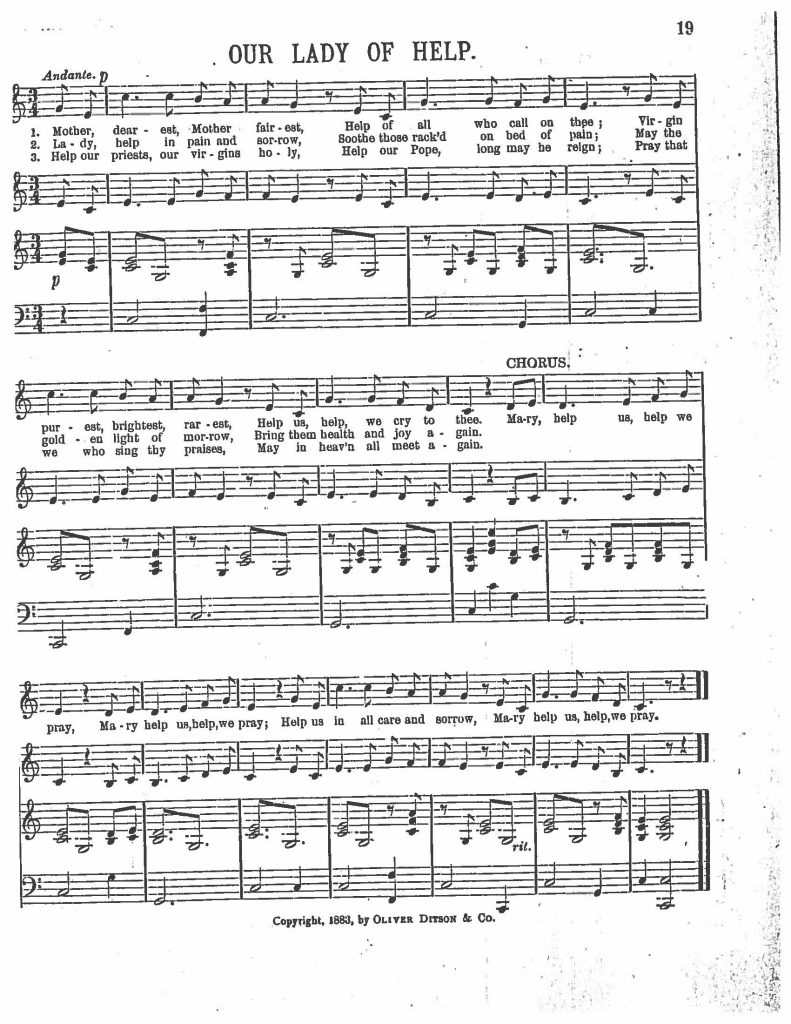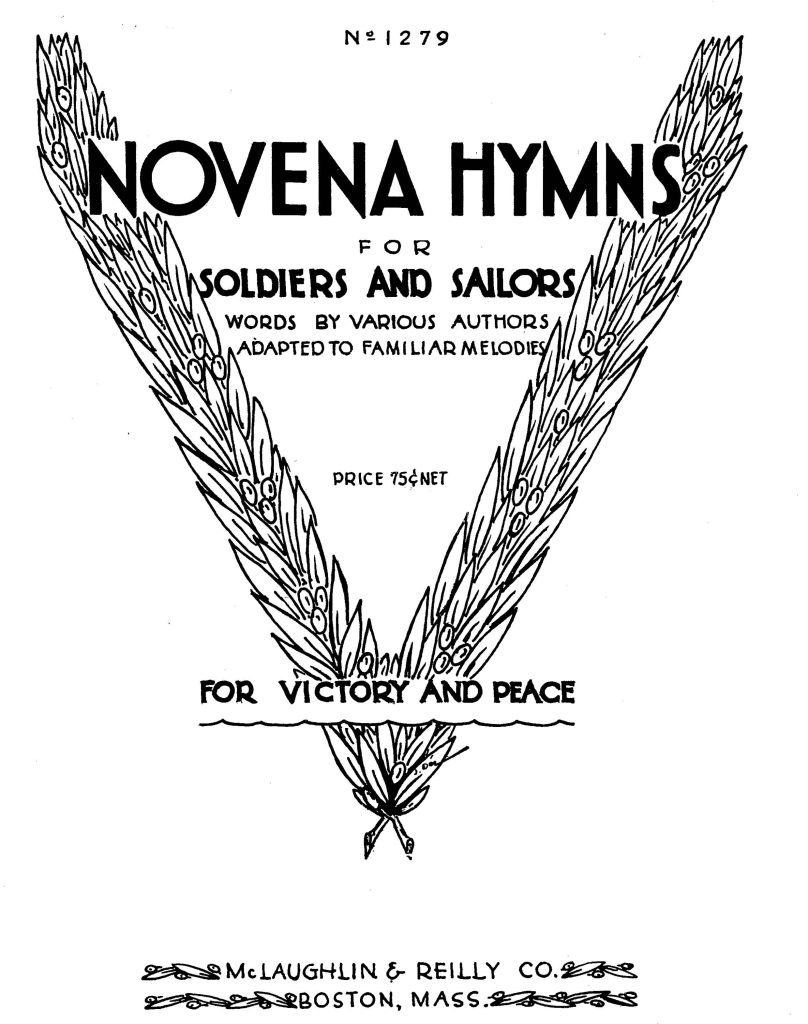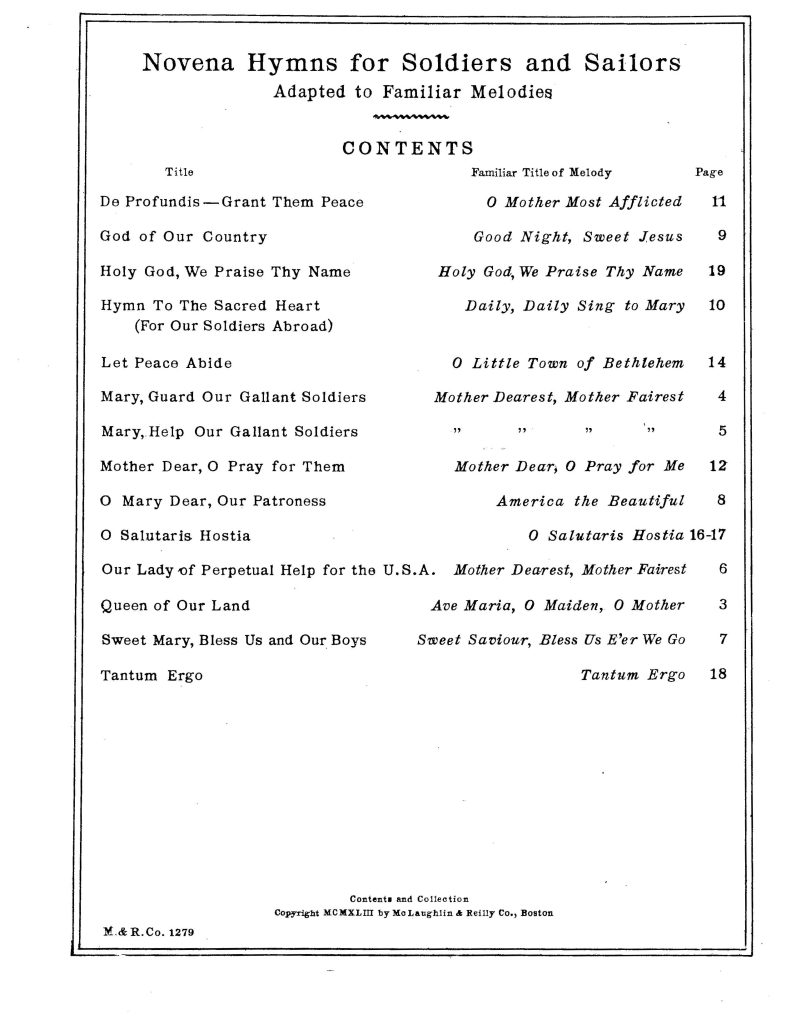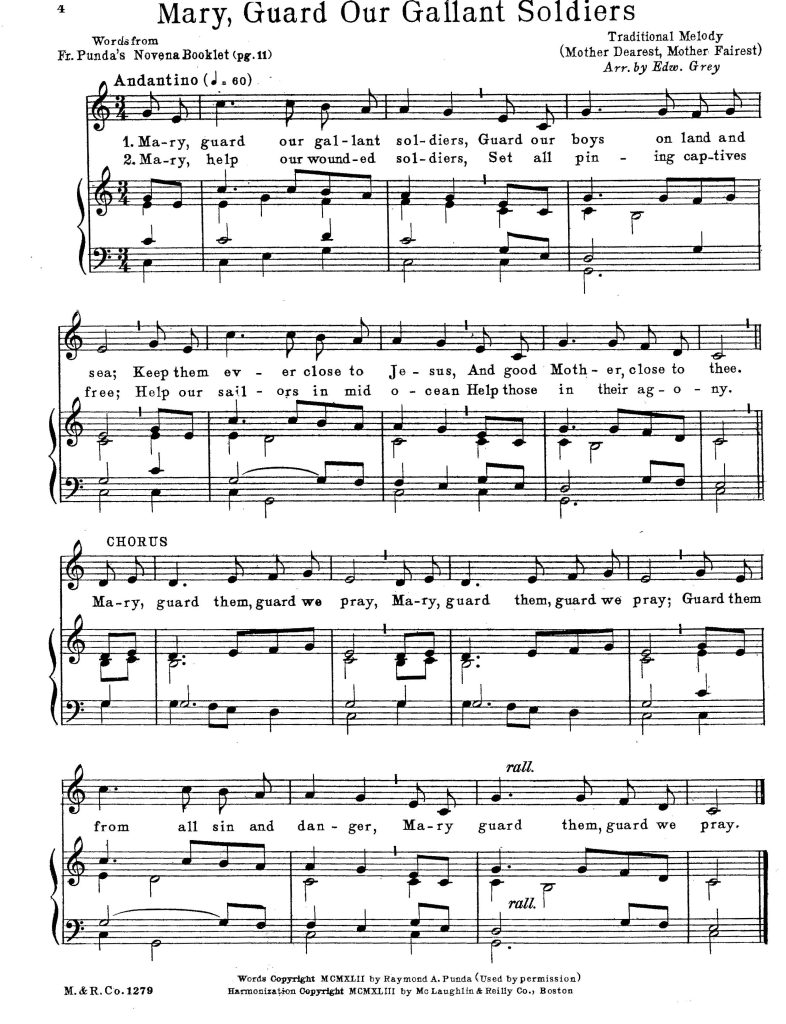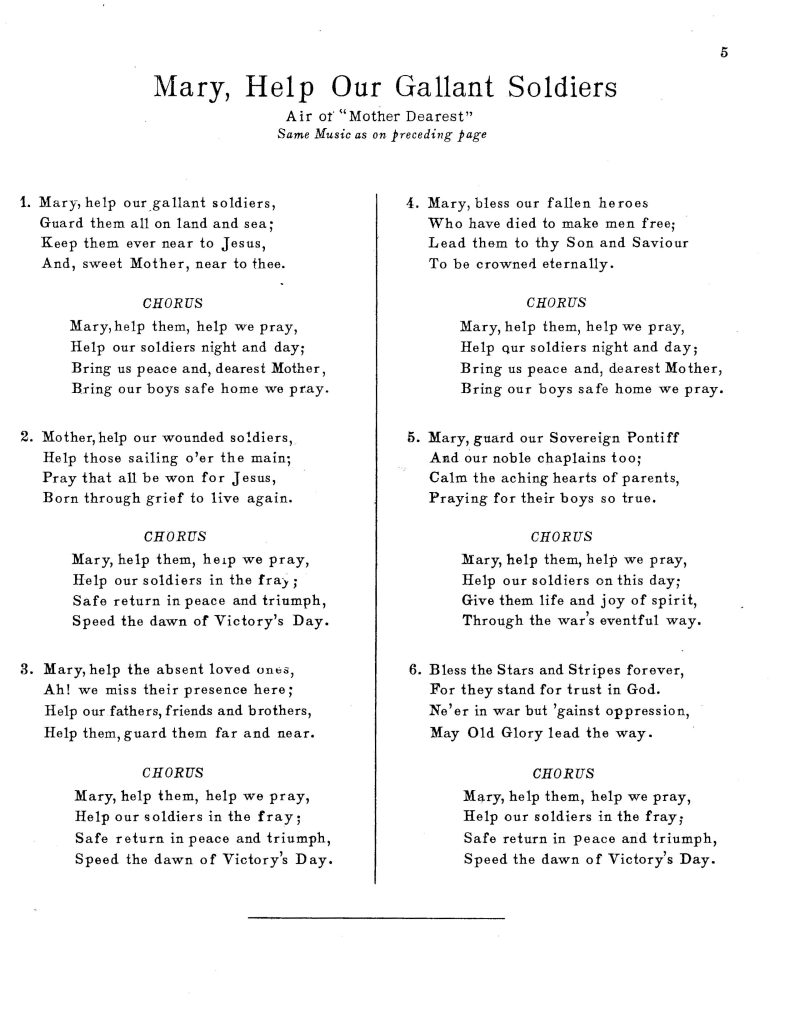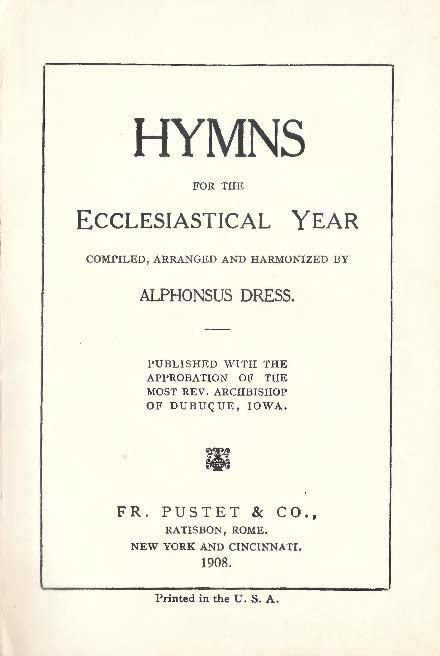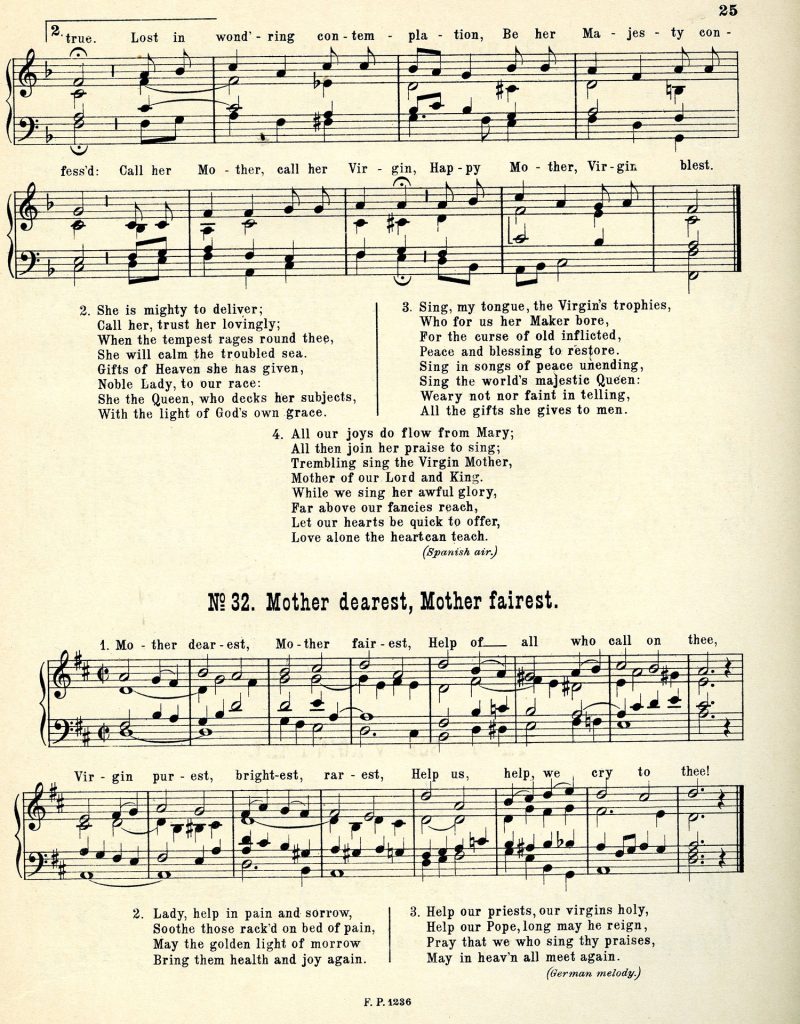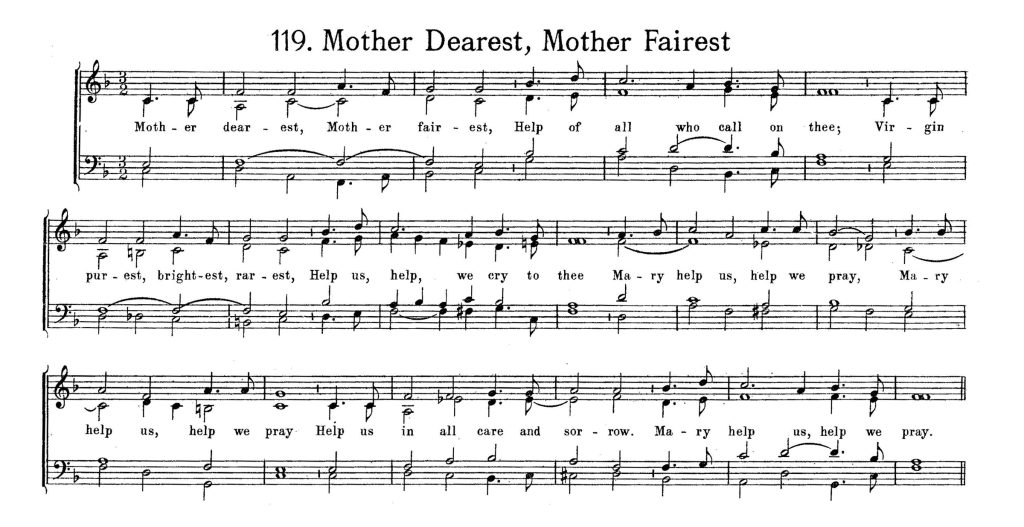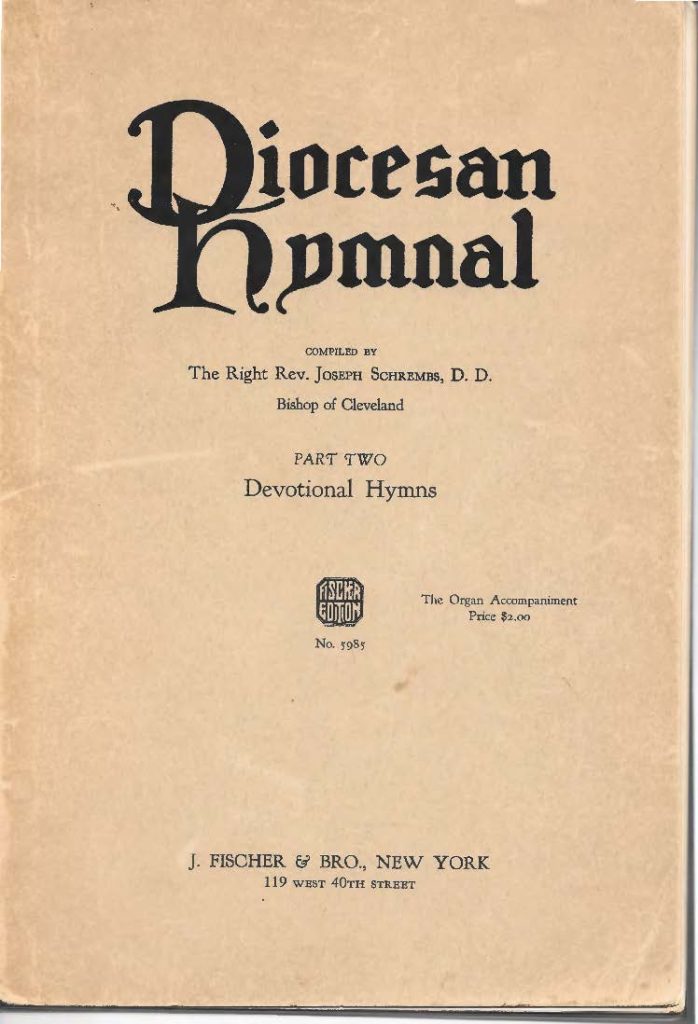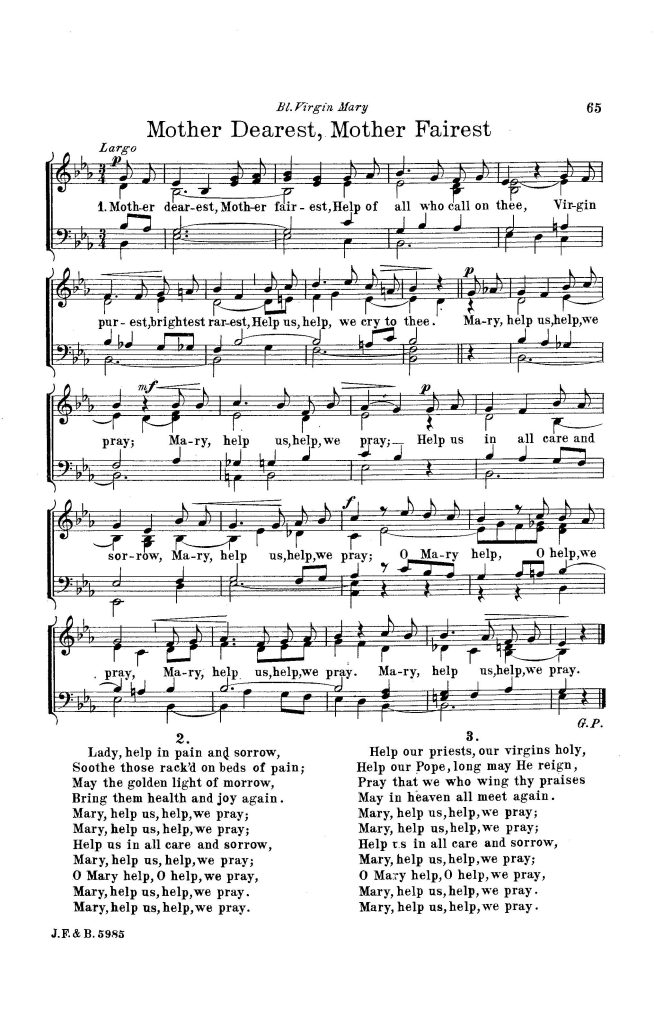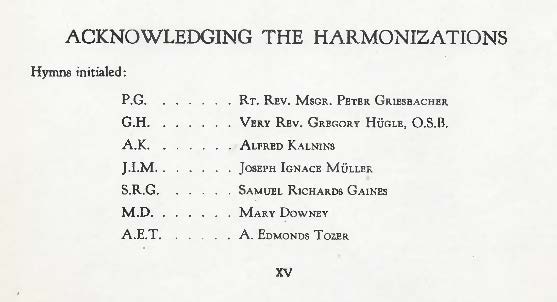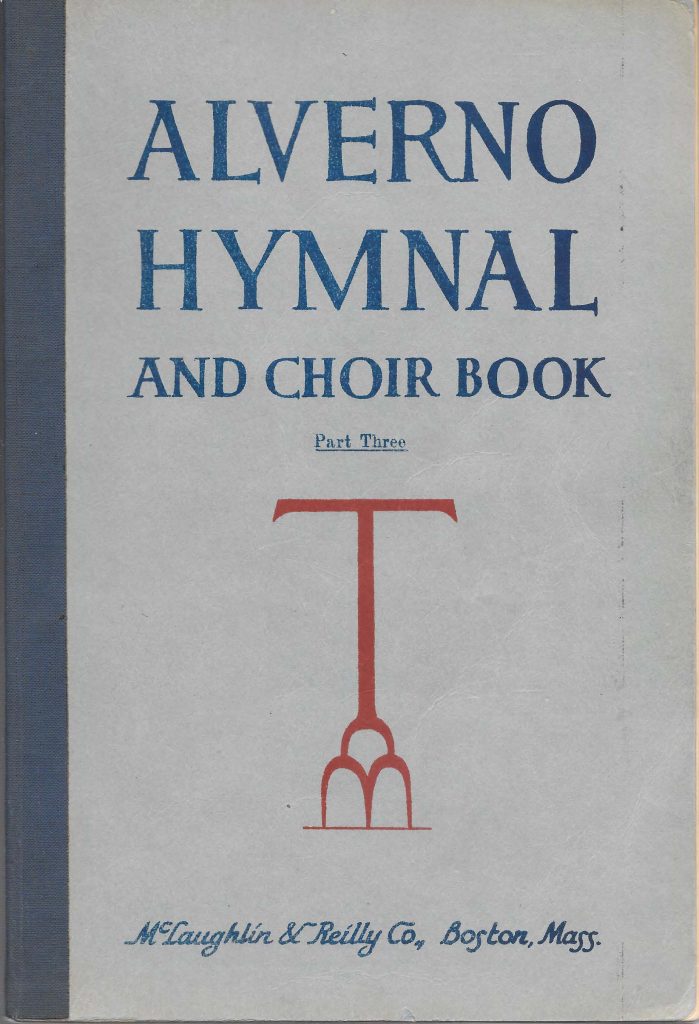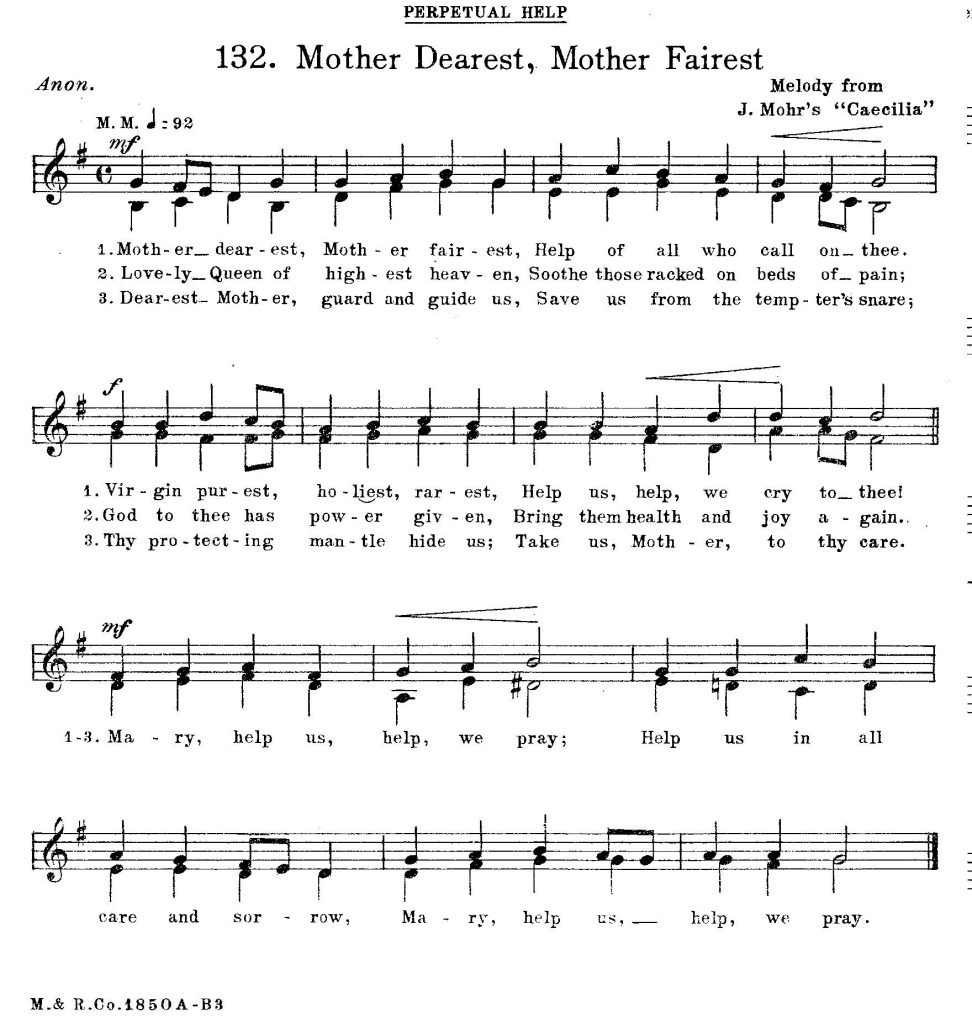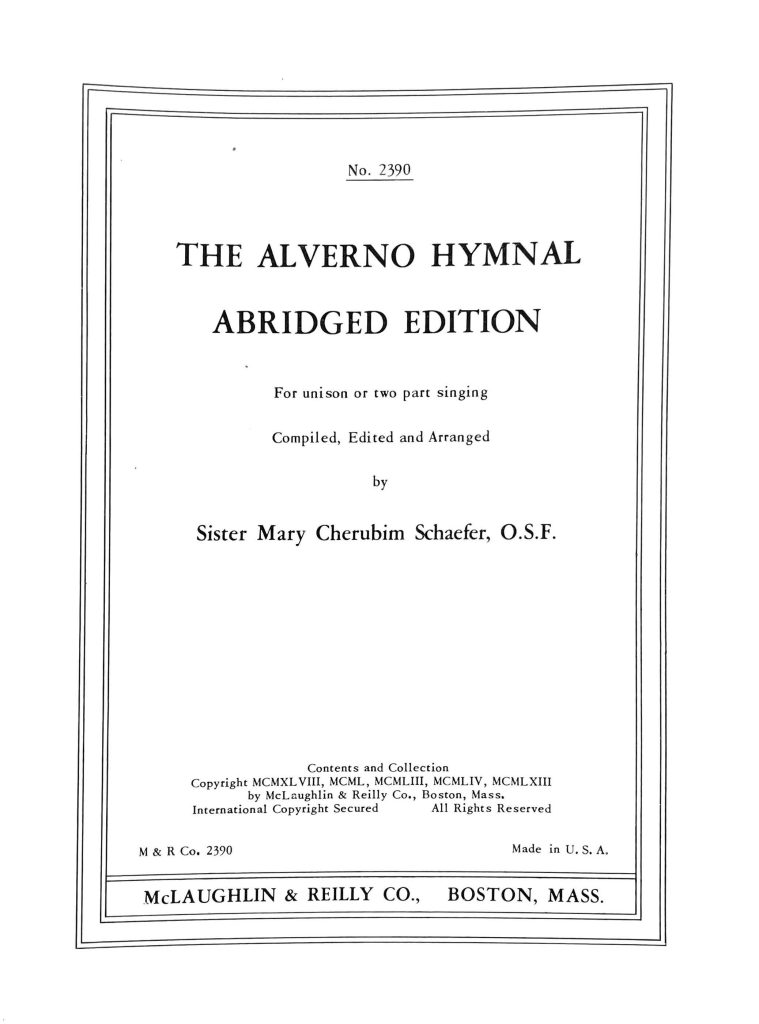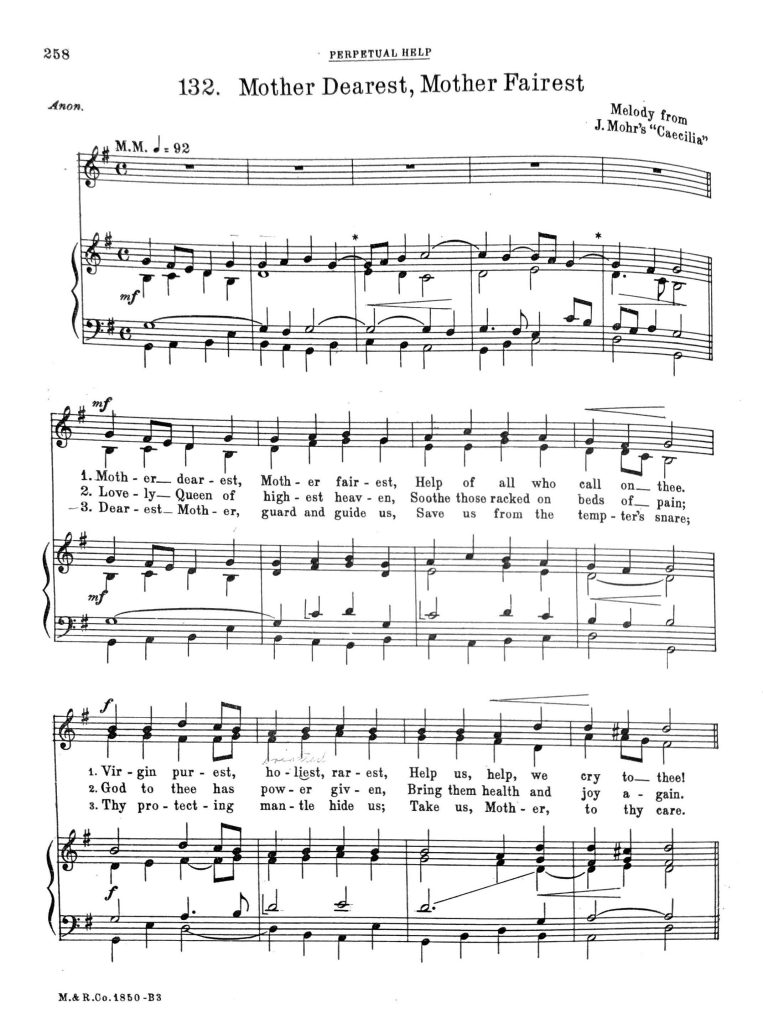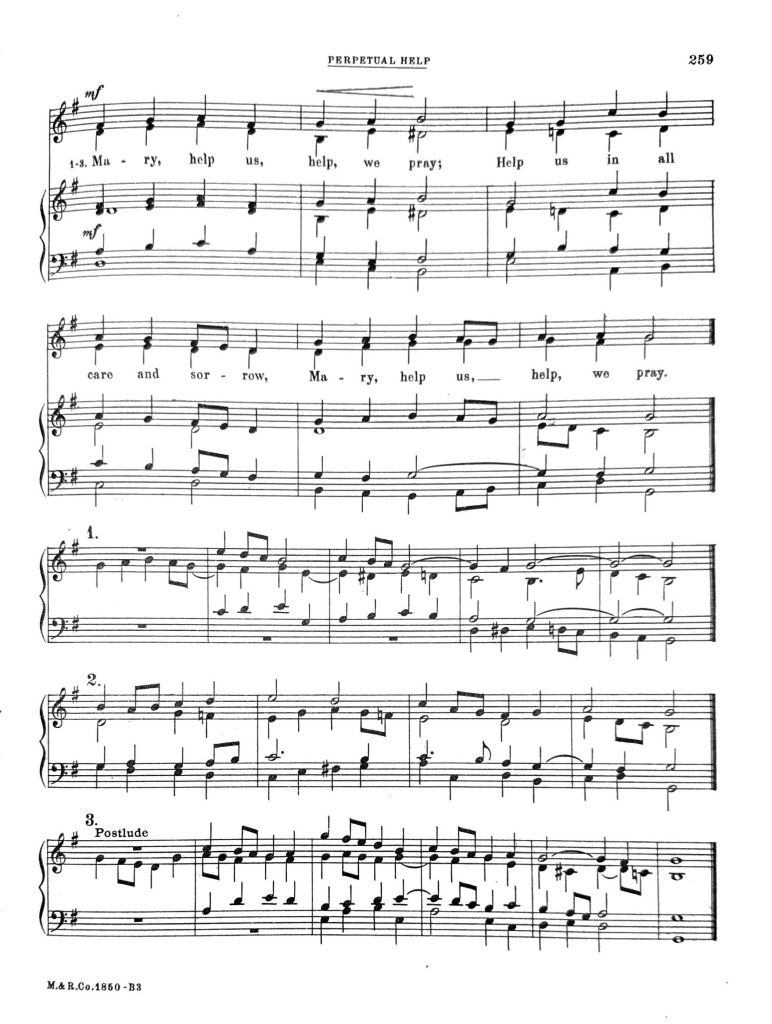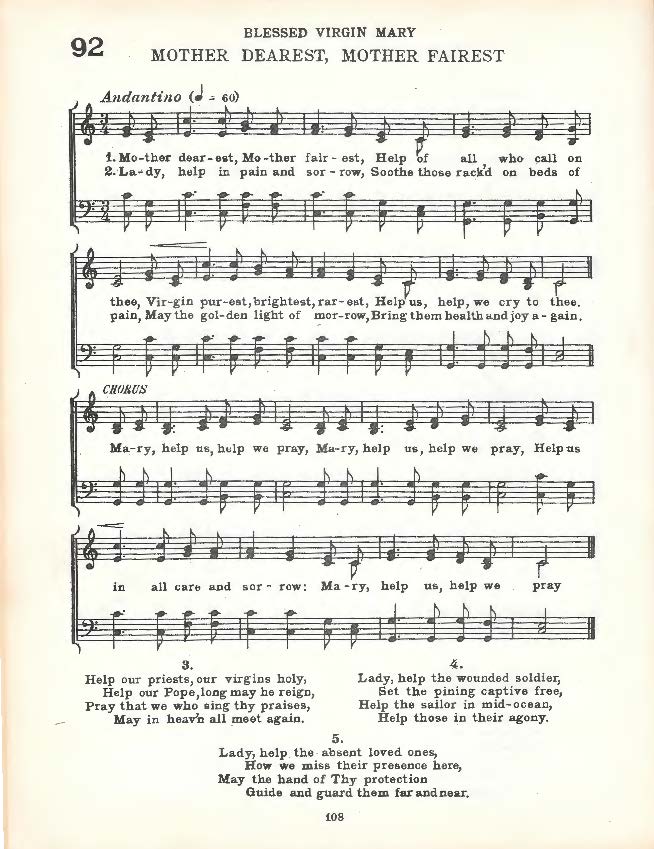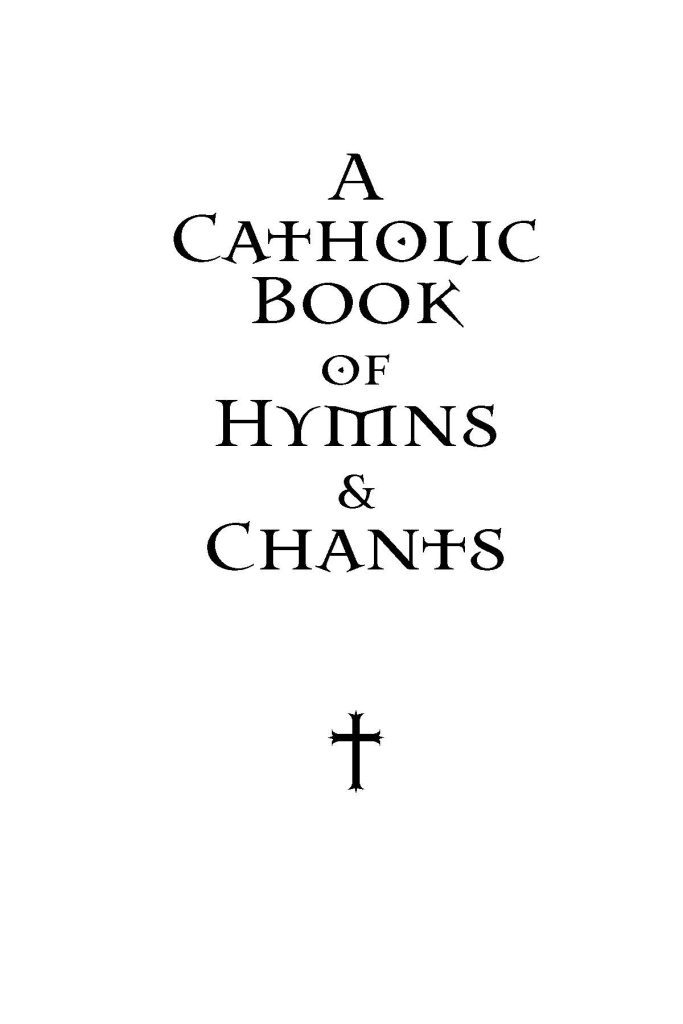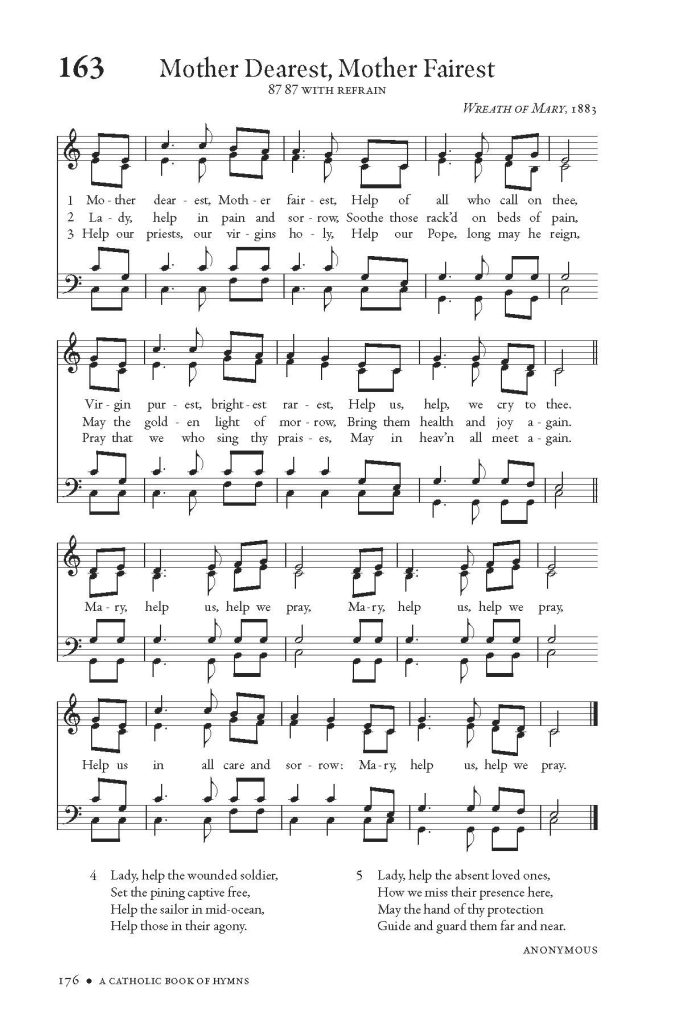The text of this hymn may have been inspired by the refrain of a hymn written by Father Frederick W. Faber (1814-1863), O Flower of Grace! Divinest Flower! The hymn can be found in the second edition of his JESUS AND MARY hymnal published in 1852. Father Faber is a convert to Catholicism, a student of St. John Henry Newman, a product of the Oxford Movement, and a priest of the Oratory of St. Philip Neri.
The words and melody that became traditional first appeared in the WREATH OF MARY compiled by the Sisters of Notre Dame de Namur and published in 1883 by the Oliver Ditson Co. and captioned Our Lady of Help.
When trying to identify Sisters who wrote hymns or composed music difficulties arise. It was the custom in many religious communities not to give credit to individuals but the whole community. For example, Words and Music by S.N.D. (Sisters of Notre Dame); Words and Music by Sisters of Mercy; Words and Music by S.S.J. (Sisters of St. Joseph); Music by Sisters of Mercy, St. Xaviers’, Chicago, Ill.
In some rare cases, authorship has been known in a verbal tradition and passed down by Sisters who knew the author or composer. There are a good many Sisters who wrote hymns, composed music, authored books, and pamphlets but their identities will forever be hidden. In other cases, authorship has been meticulously reconstructed by hymn researchers. In addition, a photograph of an individual Sister is somewhat rare and yet some photographs were taken, usually in groups. It wasn’t until after Vatican II that this custom began to change.
I recently learned through the correspondence of Peter Meggison producer of The Devotional Hymns Project that there was one Sister out of all the Sisters of Notre Dame who is generally considered the leader in the publication of all the American hymns and songs found in the hymn collections. It is likely that the words and the melody which became traditional to Mother Dearest, Mother Fairest, can be credited to Sister Aloysius (Josephine) Dorman (1835-1913).
Sister Aloysius was born in Washington D. C. on August 2, 1835 to parents Albert and Adelaide (D’Ancour) Dorman who both came from France. She entered the postulancy of the Sisters of Notre Dame de Namur at the Sixth Street Convent in Cincinnati on May 1, 1854 and professed her perpetual vows in 1861. She spent twenty-five years at the Sixth Street Academy in Cincinnati, seventeen years at the Notre Dame Academy in W. Rittenhouse Square, Philadelphia, twelve years in Dayton, and a short time in Columbus, Hamilton, and Summit. She was a teacher of music and orchestration publishing songs and hymns for the schools. After a long and fruitful service to her Lord she returned to the Notre Dame Academy in Hamilton, Ohio in November of 1912.
She was known to have a lively disposition and would often charm the hearts of those around her, but little did she know how close the end was near. On one occasion in late March of 1913, she wielded the baton for an orchestra of many instruments and sang a gypsy song accompanying herself with tambourine dancing with as much agility as if she was twenty years of age. The next day she was not well and for two weeks came only to Mass and Holy Communion but, finally she had to confine herself to her room which was just above the sacristy. Sister Aloysius Dorman died April 1, 1913 and is buried in the Notre Dame Cemetery in Hamilton, Ohio.
This short narrative of Sister Aloysius Dorman was drawn from the research provided by the Ohio Unit Archives of the Sisters of Notre Dame de Namur in Cincinnati. The research included an excerpt from a letter written by Sister Agnes Immaculata Guswiler who was the first archivist in Cincinnati serving from 1970 to 1990. The letter dated September 29, 1989, gave an outline of Sister Dorman’s service, and identifies her as the composer of all the American hymns and songs. Also, excerpts from the Hamilton Annals were provided where Sister Dorman spent her last days.
The hymn Mother Dearest, Mother Fairest appeared in editions of the SUNDAY SCHOOL HYMN BOOK, 1887 thru 1935; the ST. BASIL’S HYMNAL from 1888 thru 1925; HYMNS FOR THE ECCLESIASTICAL YEAR, 1925; the AMERICAN CATHOLIC HYMNAL, 1913 and 1921; SURSUM CORDA – A Collection of Hymns for the use of Catholic Schools, 1925; the Cleveland, Ohio DIOCESAN HYMNAL II, 1928; the ST. JOSEPH’S HYMNAL, 1930; the ALVERNO HYMNAL III, 1953; the CATHOLIC CHAPEL HYMNAL, 1944 thru 1968; OUR PARISH PRAYS AND SINGS, 1977; and A CATHOLIC BOOK OF HYMNS AND CHANTS, 2020.
The original hymn consisted of three verses. Two additional verses were added and first appeared in the Revised edition of the ST. BASIL’S HYMNAL published in 1918 – Lady, help our wounded soldiers, and Lady, help our absent loved ones. In 1943, two hymns were written for sailors and soldiers set to the traditional melody and appeared in the NOVENA HYMNS FOR SOLDIERS AND SAILORS, Mary, Guard Our Gallant Soldiers and Mary, Help Our Gallant Soldiers.
Mother Dearest, Mother Fairest although not originally written for novenas was incorporated into the evening novena programs as early as the 1930s. Among these novenas were those to Our Lady of the Miraculous Medal, the Sorrowful Mother, Our Lady of Perpetual Help, and Our Lady of Mt. Carmel. The prayers of the novena were usually followed by Benediction of the Blessed Sacrament. The evening novena programs, which included devotional hymns, were printed by the religious congregation which promoted the particular devotion (e.g., the Vincentians and Our Lady of the Miraculous Medal, the Redemptorists and Our Lady of Perpetual Help, etc.).
Many of the evening novena prayer services began to fade in Catholic parishes throughout the United States with the introduction of the Saturday Vigil Mass.
The Melodies
In addition to the traditional words and melody, I found four other melodies that were composed for this hymn. The first appeared in HYMNS FOR THE ECCLESIASTICAL YEAR published in 1908. The hymnal was compiled by Father Alphonsus Dress, Professor of Music at Loras College in Dubuque, Iowa.
Father Dress was born Alphonse Joseph Dress on April 22, 1877 in Clemency, Luxemburg to his parents Joseph and Christina (Decker) Dress. He was ordained a Catholic priest on June 19, 1904 in Milwaukee, Wisconsin by Archbishop Sebastian Gebhard Messmer (1847-1930). One of his early assignments was as Associate Pastor at St. Patrick’s in Tama, Iowa. He was then assigned to the School of the Old Masters in Ratisbon, Bavaria from 1905 to 1908 where he obtained a graduate degree (PhD) in music.
He returned to Iowa in 1908 and was the professor of music at Loras College. He compiled the HYMNS FOR THE ECCLESIASTICAL YEAR in 1908 and composed the first college song Purple and Gold in 1912. He was a staff contributor to The Catholic Choirmaster magazine from 1915 thru 1921. He also composed three choral pieces including Haec Dies, Miserere, and Terra Tremuit in 1924. These were published by J. Fischer & Bro. of New York and the copyrights were renewed in 1938. He founded the famous Loras Vested Choir in 1908 and served as faculty member of Loras College for 25 years. The college has functioned under several different names: Saint Raphael’s Seminary and later Saint Raphael’s Academy (1839–1850), Mount St. Bernard’s College and Seminary (1850–1873), St. Joseph’s College (1873–1914), Dubuque College (1914–1920), and Columbia College (1920–1939).
Father Alphonsus taught music at Loras College from 1908 until 1941. He died on November 8, 1941 and is buried at Mt. Calvary Cemetery, Dubuque, Iowa. Some of the information is this short narrative of Father Dress was provided by Archives of the Archdiocese of Dubuque, Pastoral Center.
The second melody is found in the SURSUM CORDA – A Collection of Hymns for the use of Catholic Schools. This collection of hymns was compiled and published in 1925 by the Sisters of St. Francis from Stella Niagara, New York. Organ accompaniment for this collection was provided by Father Florian Zettel, O.F.M. (1879-1947) of the Church of the Ascension in Portland, Oregon. The Sisters of St. Francis took charge of the Church of the Ascension parish school in 1917. The Sisters of St. Francis taught in the parish schools throughout California, Oregon, and Washington, often times taking charge of the schools after the Sisters of Mercy who preceded them. The melody is a variation of the tune Maria zu lieben which is used for the hymns Daily, Daily Sing to Mary and Holy Patron, thee saluting (St. Joseph).
A third melody was found in the Cleveland, Ohio DIOCESAN HYMNAL PART TWO – DEVOTIONAL HYMNS. The hymnal was compiled by Cleveland Ohio’s Bishop Joseph Schrembs, D.D., (1911-1945). Bishop Schrembs was elevated to Archbishop in 1935 and hosted the Seventh National Eucharistic Congress in Cleveland in the same year. The hymn collection was published by J. Fischer & Bro., New York in 1928.
The Diocesan Hymnal identifies this melody in the hymn index as German but does not identify the hymnal or the gesangbuch it is taken from. Many of the melodies in the hymnal were composed by Bishop Schrembs and arranged or harmonized by other composers like Rt. Rev. Monsignor Peter Griesbacher (P.G.), the Very Rev. Gregory Hügle, O.S.B. (G.H), Joseph I. Müller (J.I.M. or sometimes J.M.), and Alfred Kalnins (A.K.). The initials in the lower right of this hymn G.P. are not identified and so we are left with a mystery.
A fourth melody was found in the ALVERNO HYMNAL AND CHOIR BOOK PART 3. It was composed by Father Joseph Mohr, S.J., (1834-1892). Father Mohr is probably best known for his outstanding gesangbuchs like the Caecilia published in 1868 which contained an anthology of melodies from earlier centuries. His other collections like the Jubilate Deo published in 1877, found its way to America and helped to raise the standard of American hymnals which previously had relied on English and French sources.
The Alverno Hymnals were compiled by Sister Mary Cherubim Schaefer, O.S.F., (1886-1977). Sister Cherubim was a member of the School Sisters of St. Francis. The Alverno Hymnal was published in three parts over the course of five years. They are:
- 1948 ALVERNO HYMNAL BOOK 1 – Advent, Christmas, Holy Name, Epiphany, Holy Family
- 1950 ALVERNO HYMNAL BOOK 2 – Lent, Holy Week, Easter, Ascension, Pentecost, The Holy Trinity, Corpus Christi, Christ the King, and All Saints.
- 1953 ALVERNO HYMNAL BOOK 3 – Hymns for Low Mass, to Our Lord, the Holy Eucharist, the Sacred Heart, the Blessed Virgin Mary, Guardian Angles, Holy Souls and SS Joseph, Francis of Assisi, Patrick, Anthony, and Cecilia.
The Alverno Hymnals with English texts were among the most extensive German-American collections to use German melodies from the gesangbuchs brought over by German immigrants to the United States. Sister Cherubim’s musical accomplishments are extensive. She was the organist at St Lawrence Church, Milwaukee, and director of music at St Joseph Convent. She established the St Joseph Convent Conservatory of Music, and later St Joseph Convent College of Music, published and edited the Liturgical Choir Book, the Organist’s Companion, and she established the Alverno College of Music. She composed fort-five mass settings, hymns, motets, and numerous works for the organ and was a regular contributor to the Caecilia Magazine in the late 1930s.
Recently, the archivist for the School Sisters of St. Francis sent me a copy of the organ arrangment from the Alverno Hymnal Abridged Edition published by McLaughlin and Reilly Co., in 1963. This collection is the compilation of the three Alverno Hymnals published between 1948-1953.
Reflection
This hymn was sung before Mass on various occasions by St. Mary’s Choir in Akron, Ohio for more than thirty-five years and is one of my favorites. Someday, I’m sure this hymn will become a favorite in the repertoire of a Catholic Choir for our need of Mary’s help will never be diminished. I learned to sing this hymn using the arrangement from the St. Basil’s Hymnal.
The hymn echo’s the great Marian prayer The Memorare, Remember, O most gracious Virgin Mary, that never was it known that anyone who fled to thy protection, implored thy help, or sought thine intercession was left unaided.
Anyone who reflects on the verses of this hymn will immediately recognize some phrase that has found its way into their own lives or who has at one time, or another called on Our Lady’s help, experienced the pain and sorrow or prayed to soothe the rack’d beds of pain of someone they love. The third verse is a series of petitions to help our priests, our virgins holy, our Pope, and everyone who sings the praises of Mary that we May in heaven all meet again. The fourth verse implores Our Lady’s help for the wounded soldier, captives, sailors, and those who are suffering. The last verse implores Our Lady’s help for our absent loved ones, those in our family and friends now departed or absent from our lives for reasons we don’t yet understand, and so we ask Our Lady to guard and guide them far and near.
A special thank you to Peter Meggison producer of the Devotional Hymns Project for allowing me to link to a recording of professional voices at St. Cecilia Church, Boston, Massachusetts.
Also, to Noel Jones, AAGO in granting permission to link to A Catholic Book of Hymns and Chants with nearly three hundred time-honored traditional Catholic hymns, including Mother Dearest, Mother Fairest. You can download A Catholic Book of Hymns & Chants FREE at www.sacredmusiclibrary.com
Below are computer generated sound files of the melodies listed above. The tempo is approximate but should provide the listener with a good sense of what the hymn sounds like. All the hymns are in the public domain. I have also included a recording of this hymn as sung by The Paulist Choristers, who were featured on Catholic radio programs throughout the nation and produced a collection of Catholic Novena Hymns which were widely sung in Catholic parishes, devotions, missions, and the like.
To music and choir directors, if you use any of these selections in your Sunday or weekly music programs and you make a recording, contact the author and I may feature it in the What’s New section of Mother of Mercy Catholic Hymns.

